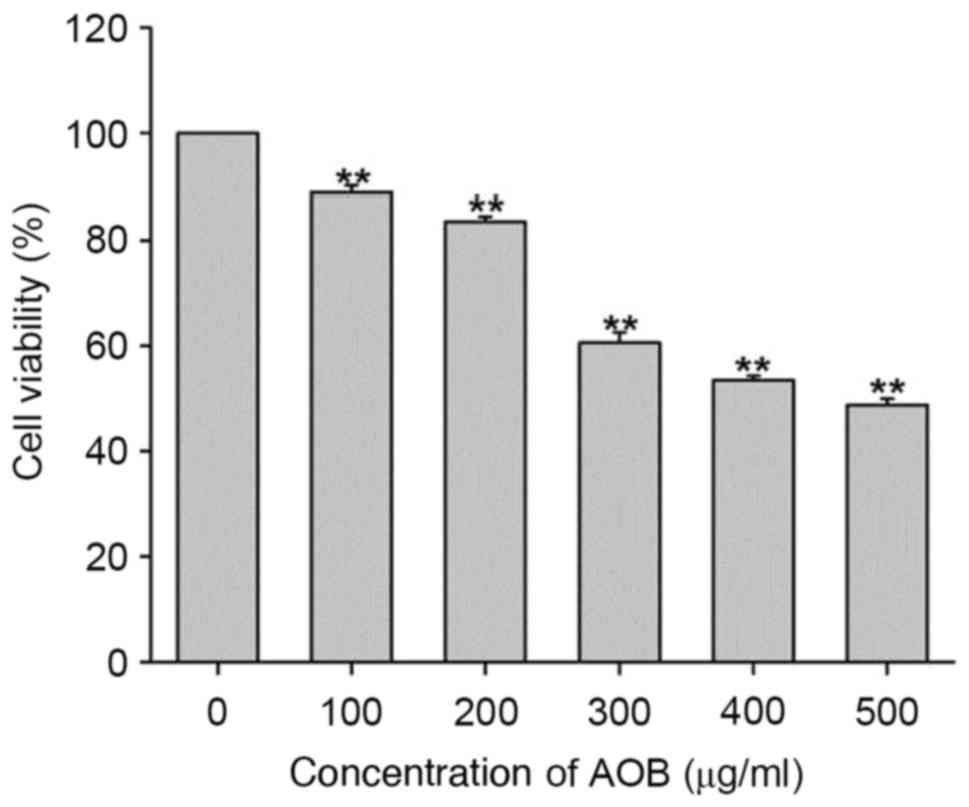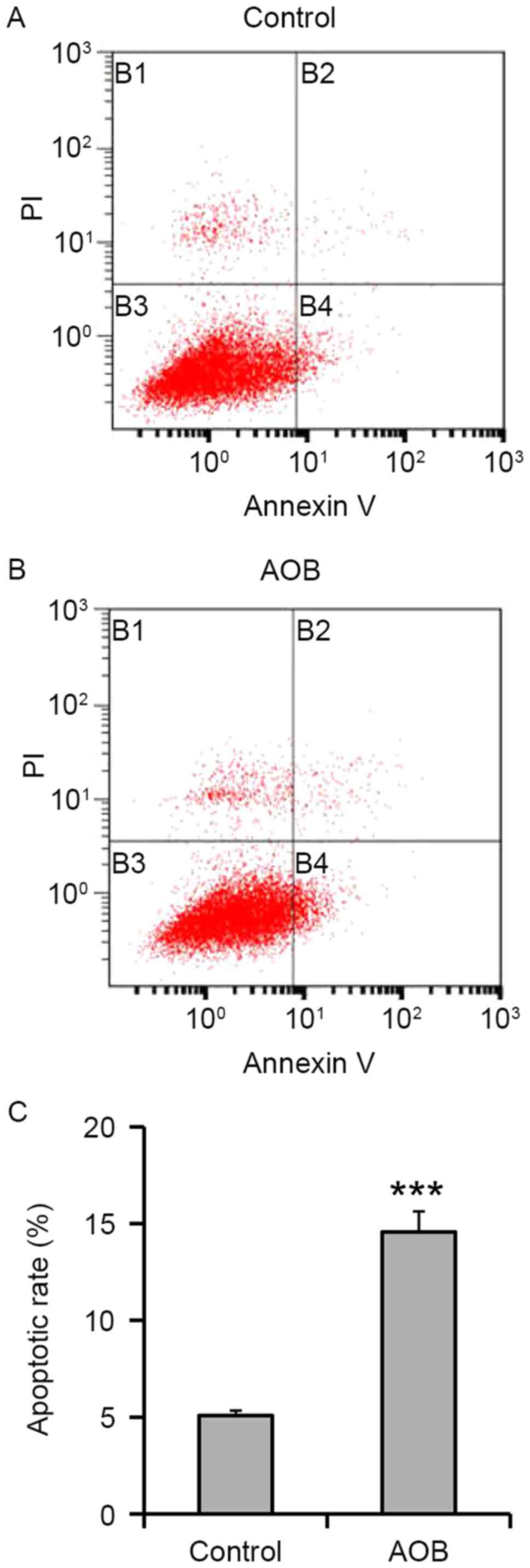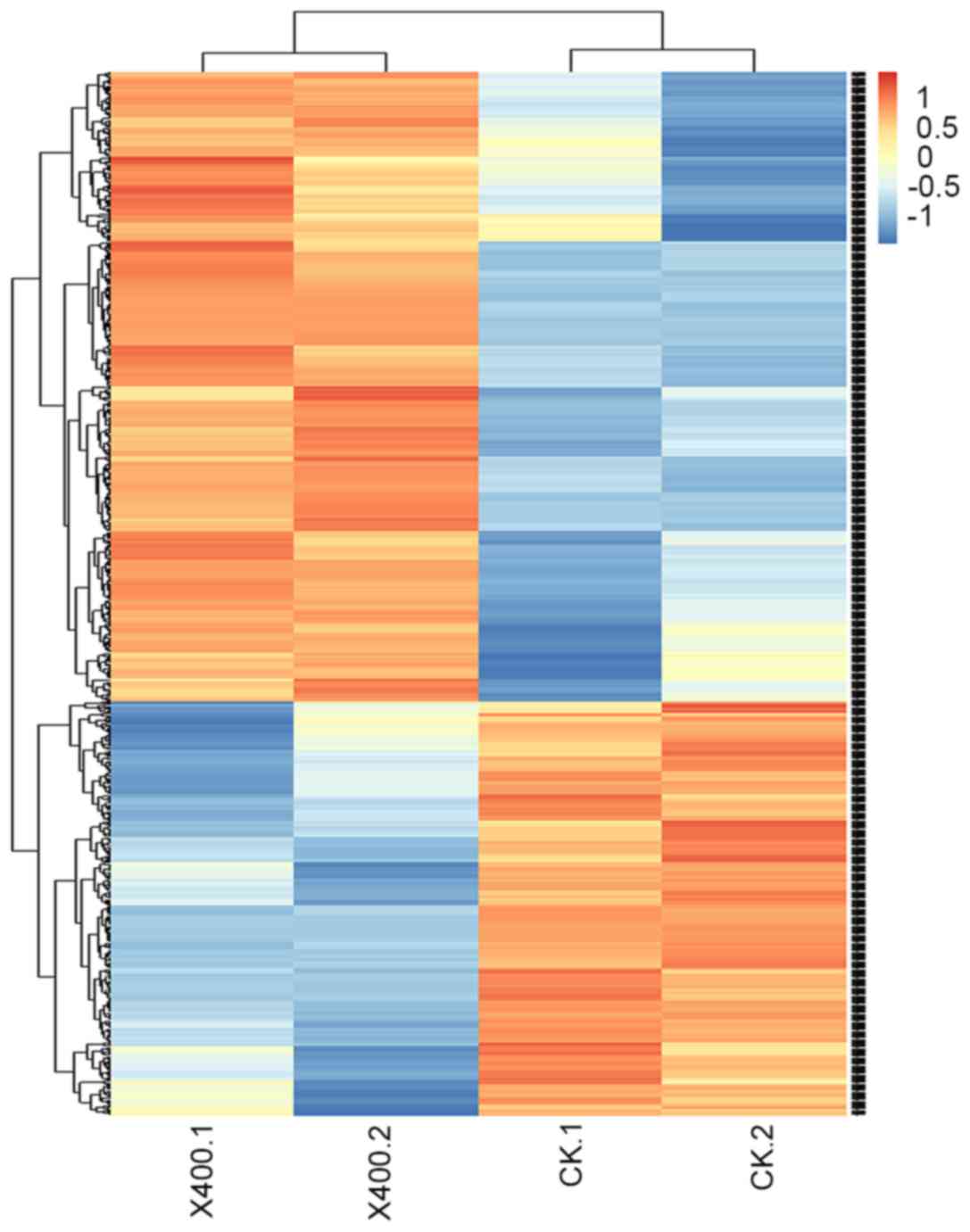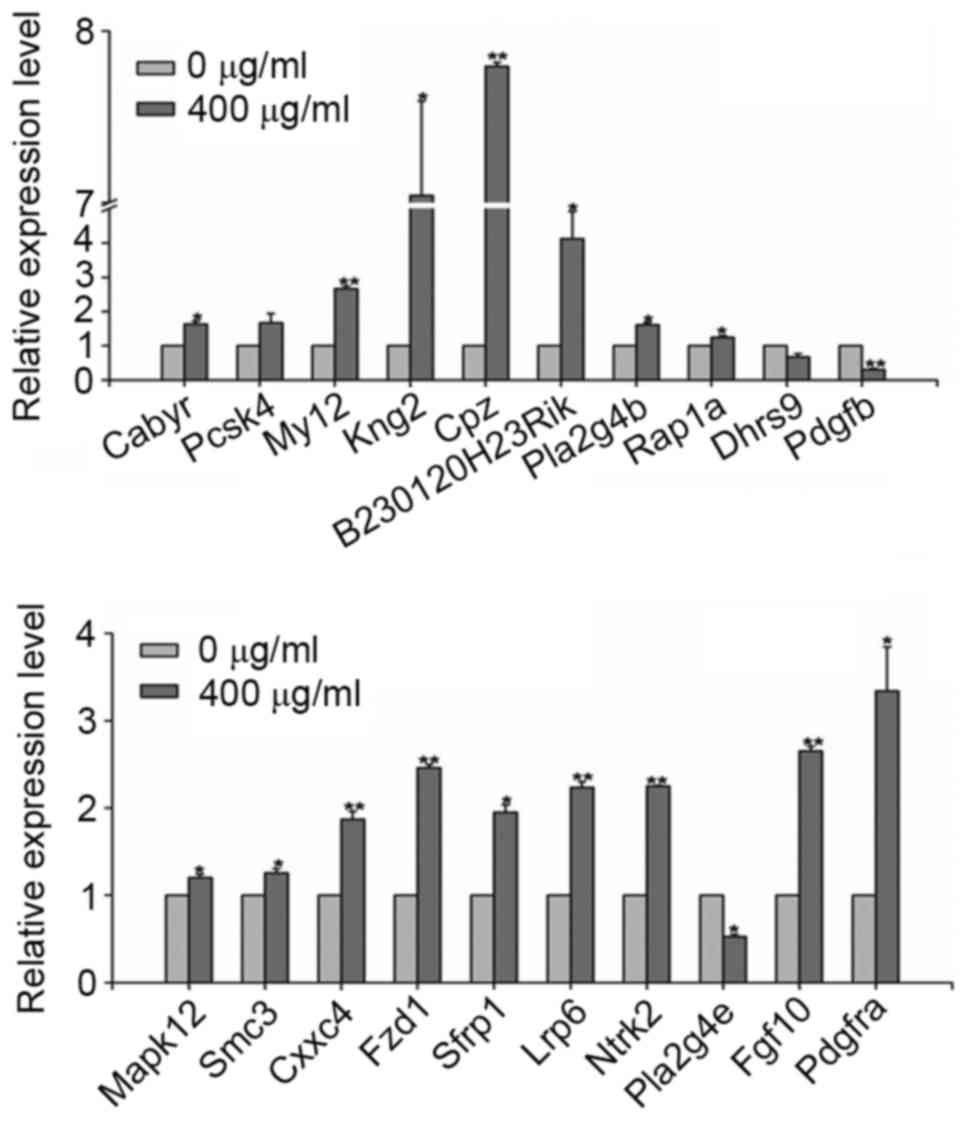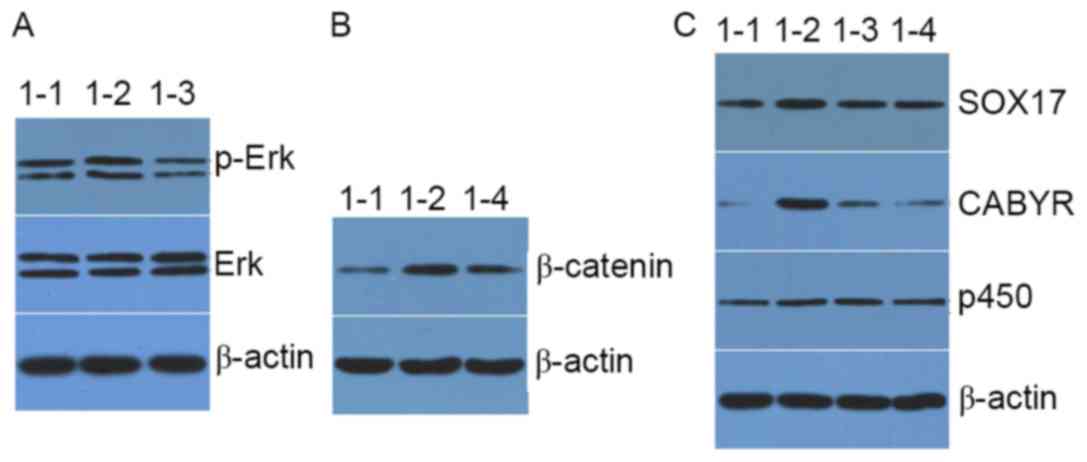Effect of antioxidant of bamboo leaves on gene expression associated with mouse embryonic fibroblast reproduction and embryonic development
- Authors:
- Published online on: September 18, 2017 https://doi.org/10.3892/mmr.2017.7505
- Pages: 7490-7496
-
Copyright: © Yu et al. This is an open access article distributed under the terms of Creative Commons Attribution License.
Abstract
Introduction
Antioxidant of bamboo leaves (AOB) was approved as a natural food additive by the Chinese Ministry of Health in 2007. AOB may be used as a food antioxidant, preservative or flavoring in numerous types of foods. AOB has several types of bioactive components including flavonoids, lactones, and phenolic acids, however, it predominantly consists of four representative flavonoids (orientin, isoorientin, vitexin, and isovitexin). AOB is obtained from bamboo leaves and has been a focus of research due to its antioxidative activity (1). However, the dose-dependent toxicity of AOB and its impact on animal reproductive and developmental function remain unclear (2). The working principle of the genechip technique is based on hybridization between target DNA/RNA extracted from cell lines or tissues and complementary short DNA-nucleotide oligomers grafted to the solid surface of the chip (3,4). Genechip has been widely used in functional genomics and investigation of pathogenic mechanisms. Mouse embryonic fibroblasts (MEF) are a type of undifferentiated cell that have the potential for infinite proliferation and totipotential differentiation (5,6). MEFs have been successfully applied in a variety of biological mechanism and toxicological studies (7,8). However, the effects of AOB on the reproductive toxicity of MEFs have not been reported. In the present study, MEF cells were used to detect the impact of different concentrations of AOB on MEF proliferation. Additionally, the gene expression of MEF cells was analyzed to explore the molecular mechanism through which AOB may affect the proliferation and apoptosis of MEFs.
The present study aimed to investigate the impact of AOB on the expression of reproduction-associated proteins. These findings may provide a broader understanding of the role of AOB in the activation of the ERK and Wnt signaling pathways.
Materials and methods
Preparation of MEFs
A total of 8 pregnant ICR mice (6 weeks old; weight, 26±5 g) were purchased from Zhejiang Academy of Medical Sciences (MIS20034; Zhejiang, China). All mice had free access to water and food and were maintained at 24°C in a humidity-controlled room with a 12–12 h light-dark cycle. Mice were sacrificed at day 13.5 of gestation by cervical dislocation. The body was placed into aseptic conditions following disinfection by immersion for 3–5 min in 75% ethanol. The uterine horns were dissected, briefly rinsed in PBS 3–5 times, and each embryo was separated from its placenta and embryonic sac. The uterus was cut open along the uterine membrane to remove the embryo that was covered by the membrane envelope, the embryos were washed with PBS and placed into a clean Petri dish. The tissue was finely minced using a sterile razor blade in order to facilitate pipetting. A total of 1 ml 0.05% trypsin/0.02% EDTA was added and cells were dissociated by pipetting up and down thoroughly and incubated for 5–10 min at 37°C. The supernatant was aspirated and the cells were centrifuged at low-speed (300 × g) at 4°C for 5 min; the supernatant was subsequently removed and the cell pellet resuspended in PBS. Cells were counted, plated in MEF medium (Bio-Rad Laboratories, Inc., Hercules, CA, USA) at a density of 35,000 cells/cm2 in 6-well plates and incubated at 37°C with 5% CO2 for 24 h. The medium was replaced with fresh MEF medium and the cells were cultured at 37°C with 5% CO2. Cells were continuously passaged or frozen for future usage when they had reached 90–95% confluence. The protocol of the present study was approved by the Ethics Committee of Zhejiang University (Hangzhou, China; approval no. ZU20150324).
Cell viability (MTT) assay
AOB was provided as a kind gift from Professor Ying Zhang (Zhejiang University). Cells were seeded at 1×105 cells/ml in a 24-well plate with final AOB concentrations of 0, 100, 200, 300, 400, 500 to 800 µg/ml, and cultured at 37°C with 5% CO2 for 72 h. Following incubation, the medium was removed and supplemented with MTT reagent (Gibco; Thermo Fisher Scientific, Inc., Waltham, MA, USA). Following incubation at 37°C for 4 h, the medium was removed and 100 µl DMSO was added to each well and agitated for 15 min at 37°C. The cell viability percentage was assessed via spectrophotometry at 570 nm using an ELx800 Absorbance Reader (BioTek Instruments, Inc., Winooski, VA, USA). Based on the results of this experiment, a concentration of 400 µg/ml AOB was used for all subsequent experiments.
Flow cytometric analysis for apoptosis quantification
Flow cytometric analysis was used to detect the apoptotic rate of cells processed with a fluorescein isothiocyanate (FITC) Apoptosis Detection kit (BD Biosciences, San Jose, CA, USA). A total of 1×106 cells were harvested and washed twice with cold PBS. Cells were subsequently washed and incubated in buffer containing 5 µl FITC-Annexin V and 5 µl propidium iodide. Apoptosis quantification was performed using an Annexin V-FITC cellular apoptosis assay reagent kit (BD Biosciences), according to the manufacturer's protocol. Cells were subsequently collected using a FACSCalibur flow cytometer and analyzed using CellQuest Software (version 3.3, BD Biosciences).
Microarray gene expression and data analysis
The RNA samples from each group were sent to Genergy Biotechnology Co., Ltd. (Shanghai, China) for Illumina MouseWG-6 v2.0 Expression BeadChip microarray analysis (Illumina, Inc., San Diego, CA, USA). The quantile measure was used to normalize the different arrays and identify differentially-expressed genes. A fold change ≥|2| and P<0.05 was considered to indicate significant differential expression of genes.
Reverse transcription-quantitative polymerase chain reaction (RT-qPCR) analysis
Total RNA was extracted using TRIzol reagent (Invitrogen; Thermo Fisher Scientific, Inc.) according to the manufacturer's protocol. Total RNA (1 µg) was reverse-transcribed to cDNA using an AccuPower RT PreMix kit (Bioneer Corporation, Daejeon, Korea), with incubations performed at 37°C for 15 min followed by 85°C for 10 sec. Gene specific primers for the 20 mRNAs and β-actin are summarized in Table I, β-actin served as an internal control for gene expression normalization. PCR amplifications were performed using Takara master mix (Takara Biotechnology Co., Ltd., Dalian, China). For each PCR, 1 µl template cDNA, equivalent to ~100 ng total RNA, was mixed with 12.5 µl 2X SYBR-Green PCR Master mix and 0.4 µM each of the forward and reverse primers in a final volume of 20 µl under the following conditions: Initial enzyme activation at 95°C for 10 min, amplification for 40 cycles (95°C for 30 sec and 60°C for 60 sec), followed by a dissociation curve analysis. The relative RNA level was calculated using the 2ΔΔCq method (9).
Western blot analysis
Total proteins were extracted separately from experimental groups and control using radioimmunoprecipitation assay lysis buffer (Beyotime Institute of Biotechnology, Jiangsu, China). A total of 60 µg of protein was separated by 10% SDS-PAGE. The proteins were subsequently transferred to polyvinylidene difluoride membranes and subjected to western blotting. Membranes were blocked in Tris-buffered saline and Tween-20 [150 mM NaCl, 10 mM Tris-HCl (pH 7.5) and 0.1% Tween-20] containing 5% (w/v) milk at room temperature for 1.5 h, and incubated with the primary and secondary antibodies. Membranes were incubated with the primary antibodies overnight at 4°C. the following antibodies were used: Rabbit anti-phosphorylated extracellular signal-regulated kinase (p-ERK; 1:1,000 dilution, cat. no. NKC20314), β-catenin (1:1,000 dilution, cat. no. NKC31478), transcription factor SOX-17 (SOX17; 1:1,000 dilution, cat. no. LUY220473), calcium-binding tyrosine phosphorylation-regulated protein (CABYR; 1:1,000 dilution, cat. no. ZYS01775), cholesterol side-chain cleavage enzyme mitochondrial (P450scc; 1:1,000 dilution, cat. no. JX012004) and β-actin (1:2,000 dilution, cat. no. KC015541) (all from Sigma-Aldrich; Merck KGaA, Darmstadt, Germany). Membranes were subsequently incubated with a horseradish peroxidase-labeled goat anti-rabbit secondary antibody (1:5,000 dilution; cat. no. MB005, Beijing Solarbio Science and Technology, Co., Ltd., Beijing, China) at 37°C for 2 h. Protein signals were detected using Electrochemiluminescence Plus Western Blotting Detection system (GE Healthcare Bio-Sciences, Pittsburgh, PA, USA). Target bands were analyzed for gray levels using ImageJ 1.37 (National Institutes of Health, Bethesda, MD, USA).
Bioinformatic analysis
The functional annotation of differentially-expressed genes was performed according to the Gene Ontology (GO) databases (http://www.geneontology.org). The GO category was classified using hypergeometric distribution, and the Benjamini and Hochberg (BH) false discovery rate (FDR) algorithm was used to adjust the resulting P-values. GO enrichment was considered to be significant if the FDR values were ≤0.05. Pathway analysis was used to identify the significant pathways of the differentially-expressed genes according to the Kyoto Encyclopedia of Genes and Genomes (KEGG; www.genome.jp/kegg). Similarly, hypergeometric distribution, followed by BH multiple testing correction, was performed to select the significant pathways, and the threshold of significance was defined as P=0.05.
Statistical analysis
All data were analyzed using SPSS 17.0 software (SPSS, Inc., Chicago, IL, USA). Experiments were performed in triplicate. Data are expressed as the mean ± standard deviation. One-way analysis of variance was performed to compare the differences among the groups. Pairwise comparisons among multiple sets of data were analyzed using the least significant difference test. P<0.05 was considered to indicate a statistically significant difference.
Results
AOB effectively inhibits MEF cell proliferation
In order to measure the cytotoxic effects of AOB, MEF cells were treated with increasing concentrations of AOB for 72 h. Subsequently, cell viability was measured using an MTT assay. The results of the present study indicated that AOB inhibited the cell growth of MEF cells more effectively at increased concentrations (Fig. 1). The IC50 value of AOB for MEF cells was 429.8 µg/ml. Compared with the control group, ~50% of MEF cells were killed by a 400 µg/ml concentration of AOB. Therefore, the concentration of 400 µg/ml was selected for the follow-up experiments.
Treatment with AOB results in increased apoptosis
In order to address the cytotoxic effects of the selected treatment, 400 µg/ml AOB-treated cells were analyzed for their apoptosis phenotype. According to the results, treatment with 400 µg/ml AOB in MEF cells for 72 h significantly increased the apoptotic population to 14.57±1.06% (P<0.001; Fig. 2), whereas the control group contained an apoptotic population of 5.09±0.26%.
Hierarchical cluster analysis
Hierarchical cluster analysis was performed to allow for the rapid detection of alterations in the levels of gene expression in addition to identification of important genes, as presented in Fig. 3. Pathway analysis was conducted to identify the significant pathways of the differentially-expressed gene sets, according to KEGG. Through a selection process, the differentially-expressed genes were determined to be primarily involved in metabolic pathways (the metabolism of exogenous substances, sugars, amino acids, glutathione and steroid hormones), apoptotic pathways, and those relevant to reproductive function.
Confirmation of gene expression by RT-qPCR analysis
In order to verify the data obtained by the microarray analysis (data not shown), RT-qPCR analysis was performed on 20 differentially-expressed genes. The results of the RT-qPCR analysis were consistent with those from the microarray analysis. As presented in Fig. 4, treatment with AOB in MEF cells resulted in the downregulation of dehydrogenase/reductase 9, phospholipase A2 group IVE and platelet derived growth factor B, while the other 17 genes were upregulated.
Effects of AOB on the mitogen-activated protein kinase (MAPK)/ERK and the proto-oncogene Wnt (Wnt) pathways
As presented in Fig. 5, treatment with AOB notably increased the expression of p-ERK, and the ERK pathway inhibitor U0126 suppressed the expression of p-ERK in AOB-treated MEF cells. Additionally, the expression of β-catenin, SOX17, CABYR and P450scc was increased following treatment with AOB, although it was decreased by treatment with AOB+U0126 and AOB+Dickkopf-related protein 1 (DKK1; a Wnt pathway inhibitor).
Discussion
MAPK signaling pathways are involved in mediating cell growth, survival and death processes. Three of the MAPK members are c-Jun N-terminal kinase, p38 and ERK (10–12). ERK is a widely-expressed protein kinase intracellular signaling molecule which is involved in the regulation of meiosis, mitosis, and postmitotic functions in differentiated cells (13). A number of different stimuli, including growth factors, cytokines, viral infection, ligands for heterotrimeric G protein-coupled receptors, transforming agents and carcinogens, may activate the ERK pathway (14). ERK serves a prominent role in the bone morphogenetic protein (BMP) and ERK/MAPK signaling pathways (15). The phosphorylation of ERK activates the BMP pathway by interacting with mothers against decapentaplegic homolog 1, 5 and 8. In addition, p-ERK exerts a function in the process of apoptosis by interacting with son of sevenless homolog and ribosomal protein S6 kinase α-1 (16).
In the results of western blot analysis performed in the present study, the expression of p-ERK significantly increased in AOB-treated MEF cells compared with control MEF cells. No notable changes in ERK expression occurred between the experimental and control groups. The results indicated that AOB may promote the phosphorylation of ERK and activate the ERK signaling pathway. Additionally, adding ERK inhibitor U0126 to AOB-treated cells downregulated the expression of p-ERK. The results of the present study demonstrated that AOB may enhance the activation of the ERK pathway, thereby influencing cellular processes.
The Wnt/β-catenin pathway facilitates an accumulation of β-catenin in the cytoplasm and its eventual translocation into the nucleus to act as a transcriptional coactivator of transcription factors (17). The results of the present study demonstrated that the expression of β-catenin increased markedly in AOB-treated MEF cells. Dkk1 is an antagonistic inhibitor of the Wnt signaling pathway that acts by isolating the low-density lipoprotein receptor-related protein 6 co-receptor so that it is unable to activate the Wnt signaling pathway (18). DKK1 has been demonstrated to antagonize the Wnt/β-catenin pathway via a reduction in β-catenin expression (18). It was previously observed that treatment with DDK1 led to a decrease in β-catenin expression in AOB-treated MEF cells (19). These previous results suggested that AOB may activate the Wnt signaling pathway by enhancing β-catenin expression, thus influencing cellular processes. CABYR and SOX17 proteins are associated with the morphological and molecular maturational processes of spermatozoa (20). P450scc, encoded by the CYP11A1 gene, is able to convert cholesterol to pregnenolone to initiate steroidogenesis (7,21). In the results of the presents study, the expression of CABYR, SOX17 and P450scc was upregulated in AOB-treated MEF cells, demonstrating that AOB may affect the regulation of reproductive function. In addition, U0126 and DDK1 inhibited the expression of CABYR, SOX17 and P450scc in AOB-treated MEF cells. The results of the present study demonstrated that these proteins were involved in the ERK and Wnt signaling pathways, and that AOB markedly upregulated the expression of CABYR, SOX17 and P450scc.
In conclusion, the present study established an MEF cell model to investigate the effects of AOB on the expression of genes associated with murine reproduction and embryonic development. The results of the present study provided evidence that AOB may impact the expression of proteins associated with reproduction. Additionally, the present findings suggested that AOB may enhance the activation of the ERK and Wnt signaling pathways, thereby influencing cellular processes. Elucidating the AOB role on signaling pathways in the MEF cell model may provide useful information for clinical reproduction and embryonic development.
Acknowledgements
The Research Fund for Giant Panda Breeding of Chengdu (grant no. CPF2012-15) and the China Agriculture Research System (grant no. CARS-05).
References
|
Lu B, Wu X, Shi J, Dong Y and Zhang Y: Toxicology and safety of antioxidant of bamboo leaves. Part 2: Developmental toxicity test in rats with antioxidant of bamboo leaves. Food Chem Toxicol. 44:1739–1743. 2006. View Article : Google Scholar : PubMed/NCBI | |
|
Ma X, Wang E, Lu Y, Wang Y, Ou S and Yan R: Acylation of antioxidant of bamboo leaves with fatty acids by lipase and the acylated derivatives' efficiency in the inhibition of acrylamide formation in fried potato crisps. PLoS One. 10:e01306802015. View Article : Google Scholar : PubMed/NCBI | |
|
Shi XC, Liu XQ, Xie XL, Xu YC and Zhao ZX: Gene chip array for differentiation of mycobacterial species and detection of drug resistance. Chin Med J (Engl). 125:3292–3297. 2012.PubMed/NCBI | |
|
Lu L, Gao Y, Xu M, Ge RC and Lu L: Gene expression profiles associated with osteoblasts differentiated from bone marrow stromal cells. Asian Pac J Trop Med. 7:344–351. 2014. View Article : Google Scholar : PubMed/NCBI | |
|
Rieske P, Krynska B and Azizi SA: Human fibroblast-derived cell lines have characteristics of embryonic stem cells and cells of neuro-ectodermal origin. Differentiation. 73:474–483. 2005. View Article : Google Scholar : PubMed/NCBI | |
|
Ngo C, Nicco C, Leconte M, Chéreau C, Arkwright S, Vacher-Lavenu MC, Weill B, Chapron C and Batteux F: Protein kinase inhibitors can control the progression of endometriosis in vitro and in vivo. J Pathol. 222:148–157. 2010. View Article : Google Scholar : PubMed/NCBI | |
|
Slominski A, Zbytek B, Nikolakis G, Manna PR, Skobowiat C, Zmijewski M, Li W, Janjetovic Z, Postlethwaite A, Zouboulis CC and Tuckey RC: Steroidogenesis in the skin: Implications for local immune functions. J Steroid Biochem Mol Biol. 137:107–123. 2013. View Article : Google Scholar : PubMed/NCBI | |
|
Wang N, Zhang W, Cui J, Zhang H, Chen X, Li R, Wu N, Chen X, Wen S, Zhang J, et al: The piggyBac transposon-mediated expression of SV40 T antigen efficiently immortalizes mouse embryonic fibroblasts (MEFs). PLoS One. 9:e973162014. View Article : Google Scholar : PubMed/NCBI | |
|
Livak KJ and Schmittgen TD: Analysis of relative gene expression data using real-time quantitative PCR and the 2(-Delta Delta C(T)) method. Methods. 25:402–408. 2001. View Article : Google Scholar : PubMed/NCBI | |
|
Bandyopadhyay M, Bishop CP and Bidwai AP: The Conserved MAPK Site in E(spl)-M8, an effector of Drosophila notch signaling, controls repressor activity during eye development. PLoS One. 11:e01595082016. View Article : Google Scholar : PubMed/NCBI | |
|
Li W, Ma Z, Ma J, Li X, Xu Q, Duan W, Chen X, Lv Y, Zhou S, Wu E, et al: Hydrogen peroxide mediates hyperglycemia-induced invasive activity via ERK and p38 MAPK in human pancreatic cancer. Oncotarget. 6:31119–31133. 2015. View Article : Google Scholar : PubMed/NCBI | |
|
Aye IL, Jansson T and Powell TL: TNF-α stimulates System A amino acid transport in primary human trophoblast cells mediated by p38 MAPK signaling. Physiol Rep. 3(pii): e125942015. View Article : Google Scholar : PubMed/NCBI | |
|
Williams KA, Zhang M, Xiang S, Hu C, Wu JY, Zhang S, Ryan M, Cox AD, Der CJ, Fang B, et al: Extracellular signal-regulated kinase (ERK) phosphorylates histone deacetylase 6 (HDAC6) at serine 1035 to stimulate cell migration. J Biol Chem. 288:33156–33170. 2013. View Article : Google Scholar : PubMed/NCBI | |
|
Ghanian MH, Farzaneh Z, Barzin J, Zandi M, Kazemi-Ashtiani M, Alikhani M, Ehsani M and Baharvand H: Nanotopographical control of human embryonic stem cell differentiation into definitive endoderm. J Biomed Mater Res A. 103:3539–3553. 2015. View Article : Google Scholar : PubMed/NCBI | |
|
Kim HK, Kim MG and Leem KH: Osteogenic activity of collagen peptide via ERK/MAPK pathway mediated boosting of collagen synthesis and its therapeutic efficacy in osteoporotic bone by back-scattered electron imaging and microarchitecture analysis. Molecules. 18:15474–15489. 2013. View Article : Google Scholar : PubMed/NCBI | |
|
Zhang YH, Cheng F, Du XT, Gao JL, Xiao XL, Li N, Li SL and de L Dong: GDF11/BMP11 activates both smad1/5/8 and smad2/3 signals but shows no significant effect on proliferation and migration of human umbilical vein endothelial cells. Oncotarget. 7:12063–12074. 2016. View Article : Google Scholar : PubMed/NCBI | |
|
Bikorimana E, Lapid D, Choi H and Dahl R: Retroviral infection of murine embryonic stem cell derived embryoid body cells for analysis of hematopoietic differentiation. J Vis Exp. 20:e520222014. | |
|
Liu L, Miao XP and Lin DX: The challenge and opportunity in the post genome-wide association study era. Zhonghua Yu Fang Yi Xue Za Zhi. 46:198–201. 2012.(In Chinese). PubMed/NCBI | |
|
Atlasi Y, Mowla SJ, Ziaee SA and Bahrami AR: OCT-4, an embryonic stem cell marker, is highly expressed in bladder cancer. Int J Cancer. 120:1598–1602. 2007. View Article : Google Scholar : PubMed/NCBI | |
|
Naaby-Hansen S, Mandal A, Wolkowicz MJ, Sen B, Westbrook VA, Shetty J, Coonrod SA, Klotz KL, Kim YH, Bush LA, et al: CABYR, a novel calcium-binding tyrosine phosphorylation-regulated fibrous sheath protein involved in capacitation. Dev Biol. 242:236–254. 2002. View Article : Google Scholar : PubMed/NCBI | |
|
Tee MK, Abramsohn M, Loewenthal N, Harris M, Siwach S, Kaplinsky A, Markus B, Birk O, Sheffield VC, Parvari R, et al: Varied clinical presentations of seven patients with mutations in CYP11A1 encoding the cholesterol side-chain cleavage enzyme, P450scc. J Clin Endocrinol Metab. 98:713–720. 2013. View Article : Google Scholar : PubMed/NCBI |



